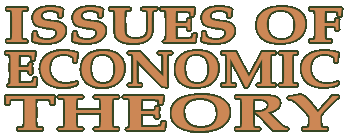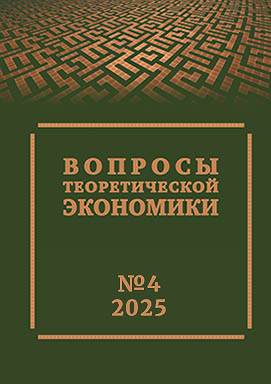PROCEDURE FOR PAPER SUBMISSION IN THE JOURNAL "ISSUES OF ECONIMIC THEORY"
Paper submission to the journal "Issues of Economic Theory" is carried out via special service. If you are unable to submit your paper through the service, please send your paper to the editorial office e-mail address: This email address is being protected from spambots. You need JavaScript enabled to view it.
Please note that by submitting a paper, you agree to the copyright agreement terms.
To expedite the work of reviewing and editing articles, we ask authors to use actual IET numbers as samples of paper design and / or adhere to the following common requirements for the design of their research:
At the beginning of the article, the surname, name, patronymic of the author (or authors separated by a comma) in Russian and English are indicated.
Title of the article (in Russian and English).
Abstract in Russian and English (at least 2 thousand characters with spaces each).
Key words in Russian and English (no more than 7 words and/or phrases).
JEL classification codes corresponding to the subject of the article based on the alphanumeric classification system in economic theory (Journal of Economic Literature);
Text of the manuscript. Text formatting requirements:
a) Times New Roman with single line spacing; surname of the author - 12th size light, straight, capital letters; title of the article - 12-point bold, straight, capital letters; keywords, abstract, footnotes - 10-point light, straight; the text of the article is 12 pt. Page margins: top - 1 cm, left - 2.0, bottom - 1.5, right - 1.5 cm;
b) tables should be numbered and have titles, and the text should contain a link to the table by the corresponding number (for example, Table 1). If tables contain footnotes, they are placed below the table. Footnote characters in tables use asterisks (*) or letters. References to sources are placed under the table after footnotes and are preceded by the word "Source:" ("Sources:") or "Calculated from:";
c) formulas are drawn up by means of the Word program, and complex formulas are typed in the built-in formula editor. If the text contains references to formulas, then the formulas should be numbered.
d) drawings (diagrams, diagrams, graphs) should preferably be prepared in vector graphics programs. Photos must be in TIFF or JPG formats with a resolution of at least 300 dpi. All figures must be numbered and have figure captions, and the text must contain links to figures by the corresponding number, for example: Fig. 12. Footnotes, notes contained in the figures are placed directly below the figures. Footnote signs use asterisks (*), letters, or other characters, but are different from table footnote signs and footnote numbers in the body text. References to sources are placed under the figures after footnotes and are preceded by the word "Source:" ("Sources:");
Bibliographic list at the end of the article in Russian and English. Notes, references, bibliographic list are drawn up in accordance with the examples below.
(a) References in the text are enclosed in square brackets, the names of the author(s) are in italics, the year of publication is in direct letters, a period, pages are capitalized, for example: [Ivanov, Petrov, 2016. p. 77]. In the case of the author's works dating from the same year, indexing in Latin letters is used [Ivanov, 2015a] [Ivanov, 2015b].
(b) Bibliographic list - a list of references to which there are references, references and citations in the text of the article. Literary sources are placed at the end of the article in alphabetical order, foreign sources after Russian ones.
Examples of the design of Russian-language literature.
Article: Каравай А.В. (2021). Институциональные барьеры роста человеческого капитала высококвалифицированных специалистов [Karavay A.V. (2021). Institutional barriers to the growth of human capital of highly-skilled professionals] // Journal of Institutional Studies. Т. 13. No 3. С. 131–143.
Monograph: Маркузе Г. (2011). Критическая теория общества: Избранные работы по философии и социальной критике [Marcuse H. (2011). Critical Theory of Society: Selected Works in Philosophy and Social Criticism]. —М.: ACT: Астрель.
Examples of the design of literature in foreign languages.
Article: Cengiz I. F. (2017). European Constitutionalism and its Future after Brexit! // Inonu University Law Review. Vol. 8. No. 2. Pr. 551-571.
Monograph: Evans J. S. B. T. (2010). Thinking Twice: Two Minds in One Brain. — Oxford and New York: Oxford University Press.
(c) If Internet sources are indicated, the date of access must be specified. Format: day, month, year. For example: accessed: 05.04.2020.
Examples of links to Internet resources:
Andrews D. (2020). Brexit and the British Constitutional Crisis. Pomona. URL: https://www.pomona.edu/node/60101/field_event_date/addtocal.ics (access date: 28.12.2021).
Brexit: United Kingdom is Divided (2016). Heinrich-Böll-Stiftung. URL: https://eu.boell.org/en/2016/06/30/brexit-united-kingdom-divided (access date: 28.12.2021).
(d) The bibliographic list does not include: normative documents, stat. collections, archival materials, newspaper notes without specifying the author, links to sites without specifying a specific material. References to such sources are given in footnotes (footnotes).
Design example: Brexit: United Kingdom is Divided (2016). Heinrich-Böll-Stiftung. URL: https://eu.boell.org/en/2016/06/30/brexit- united-kingdom-divided (accessed: 28.12.2021).
After the article, information about the author (authors) is attached:
surname, name, patronymic (in full);
academic degree, academic title;
position and place of work (full official name of the organization);
city (if it is not clear from the name of the organization);
contact e-mail (will be published in the journal). If the article is written by a group of authors, the e-mail of one of them is indicated.


